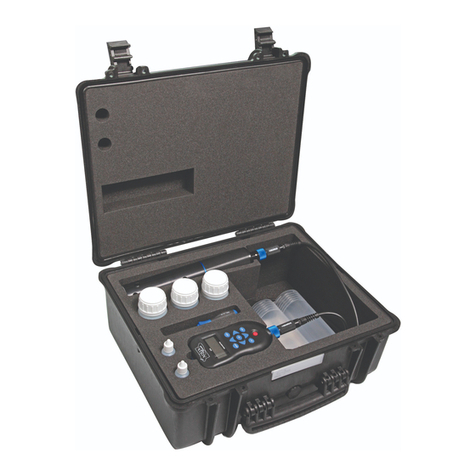LeveLine® Instruction Manual 10401-01026 Rev D
2.11.1. Lo ding Logged D t .....................................................................................................................................35
2.11.2. Selecting Corrections.....................................................................................................................................35
2.11.3. B ro Correction Overview.............................................................................................................................36
2.11.4. W ter Density Correction...............................................................................................................................36
2.11.5. Offset Correction............................................................................................................................................37
2.11.6. D t Aver ging...............................................................................................................................................37
2.11.7. Applying Corrections......................................................................................................................................38
2.11.8. Applying Multiple Corrections.......................................................................................................................38
2.11.9. Exporting Corrected D t ..............................................................................................................................38
3. LEVELINE® DEPLOYMENT.....................................................................................................................................39
3.1. IDENTIFYING THE LEVELINE® TYPE AND DEPTH RATING ...................................................................................................39
3.2. DEPLOYING THE ABS AND BARO VERSIONS....................................................................................................................39
3.2.1. Deployment in Open W ter..............................................................................................................................40
3.2.2. Choice of Suspension C ble.............................................................................................................................40
3.2.3. Deployment Depth............................................................................................................................................40
3.2.4. Deploying the ABS Logger...............................................................................................................................40
3.2.5. Deploying the G uge (Vented) Version............................................................................................................40
3.2.6. Fitting Desicc nt Housing nd C rtridge.....................................................................................................41
3.2.7. Regener ting Desicc nt....................................................................................................................................43
3.2.8. G uge (Vented) Version Zero Offset................................................................................................................43
3.2.9. Recording the Deployment Offset.....................................................................................................................43
3.3. DEPLOYING THE BARO LOGGER......................................................................................................................................44
3.4. SING THE LEVELINE® Q ICKDEPLOY™ KEY ................................................................................................................44
3.4.1. Setup Prior To Deployment with QuickDeploy™ Key..................................................................................44
3.4.2. Deploying the LeveLine® Using the QuickDeploy™ Key...............................................................................44
3.4.3. Using the QuickDeploy™ Key After Deployment............................................................................................45
3.4.4. QuickDeploy™ Key B ttery Repl cement.......................................................................................................45
3.5. DEPLOYING THE LEVELINE® MINI AND MINI-CTD .........................................................................................................45
4. LEVELINE® METER...................................................................................................................................................4
4.1. THE LEVELINE® METER AND THE ENVIRONMENT .............................................................................................................46
4.2. METER BATTERY INSTALLATION AND CARE ......................................................................................................................46
4.2.1. Choice of B ttery Type.....................................................................................................................................46
4.2.2. B ttery Life.......................................................................................................................................................46
4.2.3. B ttery Ch rging..............................................................................................................................................46
4.2.4. B ttery Condition Icon.....................................................................................................................................47
4.2.5. B ttery S ver Functions...................................................................................................................................47
4.3. OVERVIEW OF THE OPERATING SYSTEM............................................................................................................................47
4.4. INITIAL SWITCH ON AND CLOCK SET P ...........................................................................................................................47
4.5. CONNECTING TO A LEVELINE® LEVEL OR BARO LOGGING PROBE ......................................................................................48
4.5.1. Connecting the C ble to the Meter...................................................................................................................48
4.5.2. Connecting the C ble to Logger....................................................................................................................48
4.6. TAKING MEAS REMENTS................................................................................................................................................49
4.7. WHAT DOES IT ALL MEAN?.........................................................................................................................................50
4.8. GPS RECEPTION...........................................................................................................................................................50
4.9. METER SET P..............................................................................................................................................................51
4.9.1. Setting Units of Me surement...........................................................................................................................51
4.9.2. Setting the Meter Time & D te.........................................................................................................................51
4.9.3. Setting the EC Correction.................................................................................................................................52
4.9.4. Setting S linity..................................................................................................................................................52
4.10. CALIBRATING THE ELECTRICAL COND CTIVITY CELL ON - CTD PROBE MODELS ................................................................53
4.10.1. EC C libr tion St nd rds..............................................................................................................................53
4.10.2. Recognising the EC Cell.................................................................................................................................53
4.10.3. EC C libr tion Technique..............................................................................................................................53
4.10.4. EC Cell Const nt............................................................................................................................................54
4.10.5. Frequency of EC C libr tion.........................................................................................................................54
4.11. PROBE SET P (APPLICABLE TO LOGGING VERSIONS ONLY)..................................................................................................55
4.11.1. Probe Clock Setup..........................................................................................................................................55
4.11.2. Logging R te Setup.........................................................................................................................................55
4.11.3. Event Logging Setup.......................................................................................................................................56
4.11.4. Deployment Site Ident Setup...........................................................................................................................57
4.11.5. Probe Deployment Position Setup..................................................................................................................58
© 2019 quaread® Ltd. www.aquaread.com Page 4 of 90

































